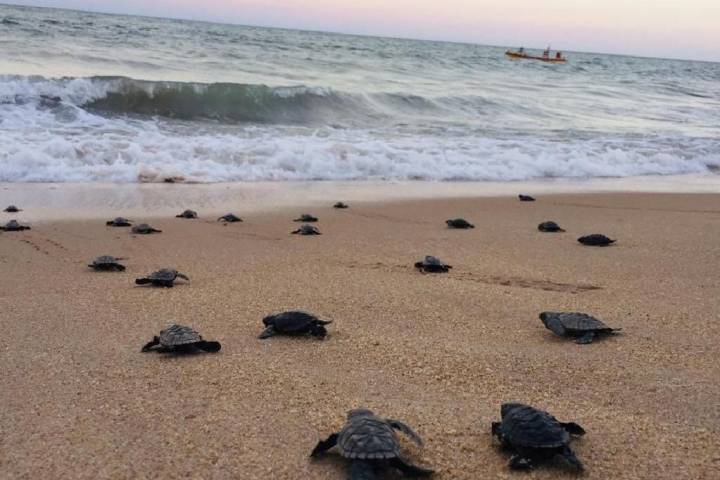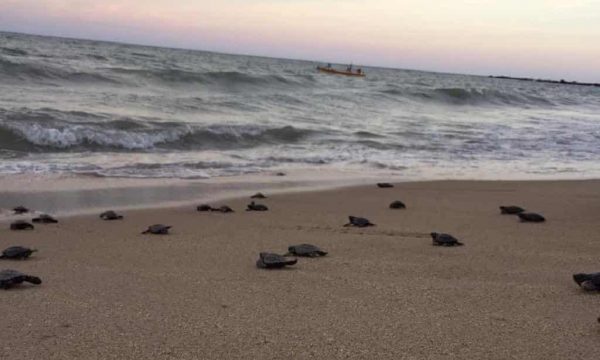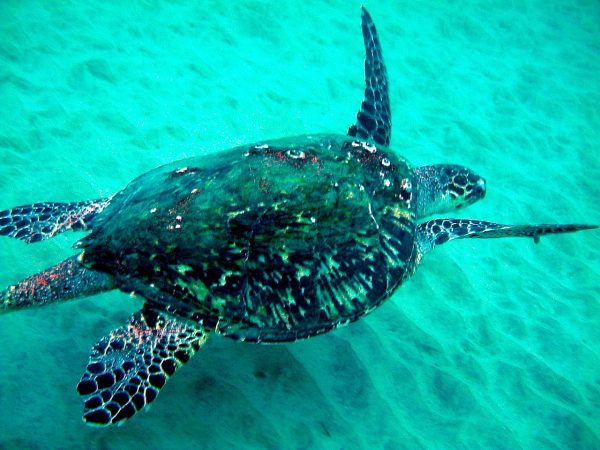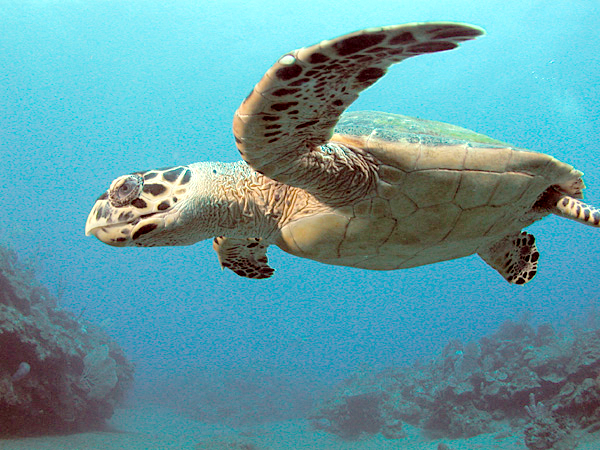Beautiful: Endangered Turtles Hatch on Brazil’s Deserted Lockdown Beaches

On April 11, 2020, in the midst of a global pandemic, almost one hundred baby hawksbill turtles hatched from the sand of a Paulista, Brazil beach and headed toward the Atlantic Ocean.
Usually people flock to the beach to watch the critically endangered turtles make their way to the waves, but with the threat of coronavirus looming large, the governor has declared a partial shutdown, forbidding residents from gathering at the beach.
According to The Guardian, Paulista’s environmental secretary, Roberto Couto commented on the amazing annual event where people can see the tiny turtles making their way to the water.

He noted, “It’s marvelous. It’s a wonderful, extraordinary feeling. This time, because of coronavirus, we couldn’t even tell people it was happening.”
The hawksbill turtle is one of the smaller turtles in the sea.
They usually reach about three feet in length and weigh about one hundred to one hundred and fifty pounds, according to Sea Turtle Conservancy They lay an average of one hundred and sixty eggs in each nest, nesting at intervals of 2 to 4 years.
During her nesting season, a female will lay between 3 to 6 times. After covering up the nest, she returns to the water and the babies are on their own.

The eggs incubate for about sixty days, and the newborns usually emerge at night because of the seashore predators. While their lifespan is unknown, it takes about twenty years for them to mature.
Today’s #OneSmileEachDay comes in the form of 97 tiny hawksbill sea turtles, which hatched last Sunday in Paulista, Brasil.
These critically endangered turtles help to protect coral reefs, which are crucial for the survival of many other creatures. pic.twitter.com/hmLItBdKCc
— WWF Cymru 🌏 (@WWFCymru) April 1, 2020
Once their shells have hardened, they are only preyed upon by sharks, octopus, and a few species of fish.
Unfortunately, according to NOAA Fisheries, along with the reduction of their main source of food, sea sponges found in coral reefs, their shells are what has caused them to become almost extinct.
The hawksbill turtles have colorful shells of amber to light brown color splashed with orange, black, and red. As far back as Roman times, these turtles were harvested for their shells to make tortoise shell combs, frames for glasses, guitar picks, jewelry, and other household ornaments.
Now that manufacturers have learned to reproduce the turtle’s colors onto plastic, there are fewer harvests, but their numbers are still suffering because of loss of habitat, getting caught in fishing nets and the rising amount of plastic that marine wildlife are accidentally ingesting.

The Convention on International Trade of Endangered Species and the World Conservation Union prohibit the trade of any turtle products on the international market, but poachers are always around.
In 1970, the United States Fish and Wildlife Service and National Marine Fisheries Service declared hawksbill turtles as endangered under the Endangered Species Act.
Hawksbill turtles are found mostly in warmer waters all over the world. Some migrate thousands of miles while others stay close to home.
They can be found in the Atlantic and Pacific Oceans as well as the Gulf of Mexico, the Cape of Good Hope in South Africa, the Caribbean Sea, the Indian Ocean, the Gulf of Thailand and in northern Australian waters.
The most popular sites for breeding occur in Mexico, the Seychelles, Indonesia, and Australia.
National Geographic suggested several places to watch sea turtles hatch once the pandemic is over. Surfing Turtle Lodge in Los Brasiles, Nicaragua has an on-site hatchery and guests can don rubber gloves and help the babies get to the water from September through July.
The Four Seasons Resort in Nevis, West Indies, has connected with the Sea Turtle Conservancy and the local Nevis Turtle Group to track the migrations of the hawksbill turtles via GPS.
From July through October, guests can assist in tagging adult turtles and mark turtle nests for their protection. Treasure Island in Fiji has the Bounty Island Hawksbill Hatchling Headstart Program where hatchlings are moved to pools approved by the Department of Fisheries and wait until they are bigger to release them.
Guests can help feed the hatchlings.
An Incredible Artifacts From Lost Viking ‘highway’ Revealed by Melting Ice
There are many other hotels that participate in sea turtle preservation allowing guests to help out and hopefully spread the news about sea turtle conservation.
